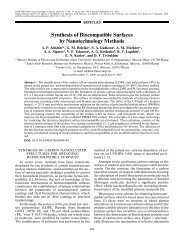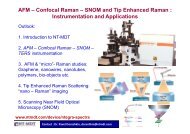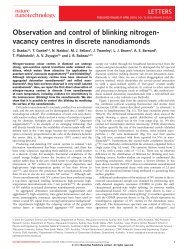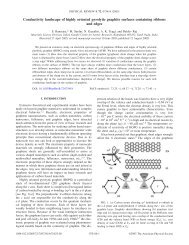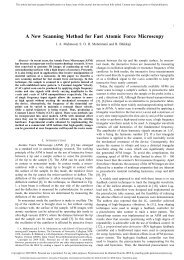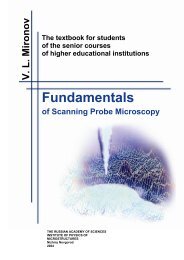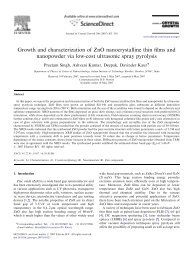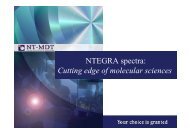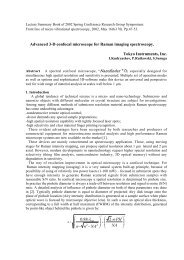AFM study of morphological changes associated with ...
AFM study of morphological changes associated with ...
AFM study of morphological changes associated with ...
Create successful ePaper yourself
Turn your PDF publications into a flip-book with our unique Google optimized e-Paper software.
J Solid State Electrochem (2008) 12:739–746 745<br />
Fig. 8 Raman spectra obtained for a TCNQ adhered to a gold slide<br />
electrode before reductive electrolysis; b, c, and d MTCNQ formed by<br />
reductive electrolysis for 10 min when TCNQ is adhered to a gold<br />
slide electrode in contact <strong>with</strong> aqueous 0.1 M CuSO 4 (b), 0.1 M<br />
CoCl 2 (c), 0.1 M NiCl 2 (d); e Spectrum produced by oxidative<br />
electrolysis <strong>of</strong> Ni[TCNQ] 2 (H 2 O) 2 formed in (d)<br />
crystals having a length <strong>of</strong> ∼2 μm and a width <strong>of</strong> ∼100–<br />
200 nm. This observation supports the hypothesis that the<br />
initial nucleation sites occur at locations where direct<br />
contact between electrode surface, electrolyte and solid<br />
TCNQ occurs. Presumably, ingress <strong>of</strong> Co 2þ ðaqÞ may occur<br />
below the bottom face <strong>of</strong> the TCNQ surface because neither<br />
the TCNQ solid nor electrode surface are fully flat, thereby<br />
allowing aqueous electrolyte to penetrate between these two<br />
regions.<br />
Ni[TCNQ] 2 (H 2 O) 2<br />
Ni[TCNQ] 2 (H 2 O) 2 is formed by solid–solid conversion <strong>of</strong><br />
TCNQ (Eq. 3) in an analogous manner to that for Co<br />
[TCNQ] 2 (H 2 O) 2 . Ni[TCNQ] 2 (H 2 O) 2 also exists in only one<br />
phase as rod-like crystals. However, Ni[TCNQ] 2 (H 2 O) 2<br />
forms much smaller crystals than Co[TCNQ] 2 (H 2 O) 2 <strong>with</strong> a<br />
preferential orientation into the bulk solution. Fig. 7<br />
contains <strong>AFM</strong> images after reductive electrolysis for<br />
5 min at different magnifications. Typically, the numerous<br />
tiny Ni[TCNQ] 2 (H 2 O) 2 rods protrude from the substrate.<br />
The typical size detected under conditions <strong>of</strong> Fig. 7 is<br />
300 nm in length and 80 nm in width. In contrast, the<br />
dominant feature in images <strong>of</strong> Co[TCNQ] 2 (H 2 O) 2 were<br />
horizontally oriented and were much longer rods <strong>of</strong> 1.5 μm<br />
in length and 300 nm wide.<br />
Raman spectroscopic characterization <strong>of</strong> solid–solid<br />
electrochemical conversion<br />
Raman spectra [37–40] obtained in the ex situ mode allow a<br />
ready distinction between TCNQ and [TCNQ] .− -containing<br />
compounds, and hence, allow the course <strong>of</strong> reduction and<br />
oxidation on the surface <strong>of</strong> 50×50 μm 2 crystals to be<br />
monitored. Thus, upon solid–solid transformation <strong>of</strong> TCNQ<br />
into MTCNQ, it is expected that the frequency <strong>of</strong> the<br />
1,454 cm −1 C–CN stretch in TCNQ (Fig. 8a) would shift to<br />
about 1,380 cm −1 if [TCNQ] .− is formed. In addition, the<br />
2,225 cm −1 C≡N stretching band (Fig. 8a) in TCNQ shoud<br />
shift to a lower wavelength upon reduction, and the total<br />
Raman intensity should drop significantly due to the higher<br />
absorbance <strong>of</strong> MTCNQ and concomitant decrease in the<br />
scattering volume [37–40].<br />
In the case <strong>of</strong> electrochemical formation <strong>of</strong> CuTCNQ<br />
and Co[TCNQ] 2 (H 2 O) 2 (see Fig. 8b,c) by reductive<br />
electrolysis <strong>of</strong> TCNQ for 10 min, ex situ detection <strong>of</strong><br />
Raman bands at 1,383 and 1,390 cm −1 , respectively is<br />
indicative <strong>of</strong> [TCNQ] .− formation. However, retention <strong>of</strong><br />
the band at 1,454 cm −1 indicates that residual TCNQ also is<br />
still present. The TCNQ band at 2,226 cm −1 shifts only<br />
slightly to around 2,220 cm −1 . Thus, according to Raman<br />
spectra evidence, the majority <strong>of</strong> the 50×50 μm 2 TCNQ<br />
surface has been changed to M + [TCNQ] .− , but some TCNQ<br />
remains. The laser detection spot used in Raman spectroscopy<br />
can penetrate to a depth <strong>of</strong> several microns. Thus,<br />
residual TCNQ, which is detected, may not lie on the<br />
surface. For Ni[TCNQ] 2 (H 2 O) 2 , the transformation is<br />
quantitative <strong>with</strong> respect to Raman spectroscopic evidence<br />
(Fig. 8d). In this case, the 1,454 cm −1 band fully disappeared<br />
upon reduction, while the 2,225 cm −1 band shifted<br />
to 2,209 cm −1 . It is plausible that this is <strong>associated</strong> <strong>with</strong> the<br />
much smaller Ni[TCNQ] 2 (H 2 O) 2 crystal size and their<br />
prevailing direction into the solution phase. Ex situ Raman<br />
spectra (Fig. 8e) shows that after applying a potential<br />
required to transform Ni[TCNQ] 2 (H 2 O) 2 back to TCNQ,<br />
the 2,209 cm −1 resonance reverts back to 2,224 cm −1 ,as<br />
expected if MTCNQ is transformed back to TCNQ <strong>with</strong><br />
egress <strong>of</strong> the Ni 2+ ions. However, the 1,377-cm −1 resonance<br />
remains detectable, although significantly lower in intensity.<br />
A similar situation prevails for the other TCNQ/<br />
MTCNQ processes. These data, in agreement <strong>with</strong> conclusions<br />
reached by in situ <strong>AFM</strong> morphology data, suggest<br />
that while most <strong>of</strong> the solid MTCNQ can be electrochemically<br />
converted back to TCNQ, residual amounts remain<br />
even when the potential is held at sufficiently positive<br />
potential for long periods <strong>of</strong> time.<br />
Conclusions<br />
In situ <strong>AFM</strong> images <strong>of</strong> the electrochemically induced solid–<br />
solid TCNQ/MTCNQ transformation provides insights into<br />
the nucleation growth process that allow redox interconversion<br />
<strong>of</strong> the two solids. By controlling the time <strong>of</strong><br />
reductive electrolysis, nearly mono-dispersed rod-like



